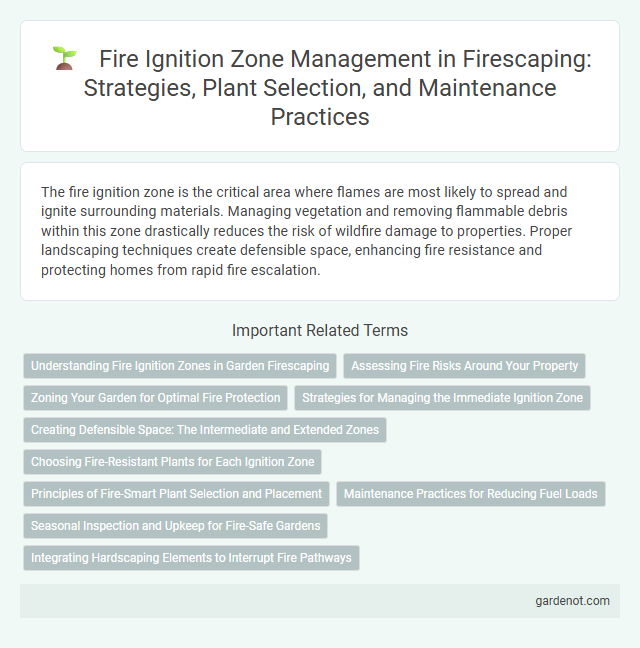The fire ignition zone is the critical area where flames are most likely to spread and ignite surrounding materials. Managing vegetation and removing flammable debris within this zone drastically reduces the risk of wildfire damage to properties. Proper landscaping techniques create defensible space, enhancing fire resistance and protecting homes from rapid fire escalation.
Understanding Fire Ignition Zones in Garden Firescaping
Fire ignition zones in garden firescaping refer to the critical areas around a property where vegetation and combustible materials can ignite from external fire sources or embers. Identifying and managing these zones involve creating defensible spaces by strategically selecting fire-resistant plants, maintaining appropriate plant spacing, and reducing fuel loads to minimize fire spread. Effective fire ignition zone management enhances property protection by decreasing the chances of fire entering structures and supports overall wildfire resilience.
Assessing Fire Risks Around Your Property
Fire ignition zones define the critical areas where wildfires are most likely to start, often within 30 feet of structures and vegetation clusters. Assessing fire risks around your property involves identifying flammable materials, dry brush, and potential ember entry points in this zone to create defensible space. Implementing strategic vegetation management and using fire-resistant landscaping reduces ignition potential and enhances overall property safety.
Zoning Your Garden for Optimal Fire Protection
Designing a fire ignition zone involves strategically dividing your garden into zones based on vegetation types, distance from structures, and flammability levels. Zone 1, closest to buildings, should contain fire-resistant plants with low sap and resin content, minimal mulch, and regular maintenance to reduce fuel buildup. Creating buffer zones with gravel paths, irrigated lawns, or hardscaping materials effectively slows fire spread, enhancing overall garden fire protection.
Strategies for Managing the Immediate Ignition Zone
Managing the immediate ignition zone in firescaping involves clearing all flammable materials within 5 feet of structures to reduce fire ignition risk. Using non-combustible landscaping elements such as gravel or stone mulch creates a defensible space that limits flame contact. Regular maintenance including pruning, removing dead vegetation, and spacing plants to prevent continuous fuel beds enhances ignition zone resilience.
Creating Defensible Space: The Intermediate and Extended Zones
Creating defensible space in the fire ignition zone involves managing the Intermediate and Extended Zones by reducing combustible vegetation and maintaining proper spacing between plants to slow fire spread. The Intermediate Zone typically extends 30 to 100 feet from structures, requiring selective thinning and removal of ladder fuels to minimize flame intensity and protect homes. The Extended Zone, ranging from 100 to 200 feet or more, focuses on overall landscape resilience through strategic vegetation management and reducing continuous fuel loads to prevent large-scale fire advancement.
Choosing Fire-Resistant Plants for Each Ignition Zone
Selecting fire-resistant plants tailored to each fire ignition zone significantly reduces wildfire risk and enhances property protection. Low ignition zones benefit from succulents and deciduous shrubs with high moisture content, while moderate zones require fire-resistant evergreens and native grasses with minimal resin. Understanding plant flammability and strategically placing vegetation based on ignition zones optimizes firescaping effectiveness and supports fire-safe landscaping goals.
Principles of Fire-Smart Plant Selection and Placement
Fire ignition zones require strategic firescaping by prioritizing fire-resistant plant species with low resin, oil, and sap content to minimize flammability. Proper placement involves creating defensible space by spacing plants to reduce fuel continuity and using hardscape elements like gravel or stone to interrupt fire pathways. Selecting native, drought-tolerant vegetation adapted to local conditions also enhances fire resilience and ecosystem stability.
Maintenance Practices for Reducing Fuel Loads
Regular removal of dead vegetation, fallen leaves, and dry brush within the fire ignition zone significantly reduces available fuel and minimizes ignition risk. Implementing controlled pruning and mowing maintains low fuel density, improving defensible space around structures. Consistent debris clearance and seasonal inspections ensure optimal fire ignition zone maintenance and effectively decrease fire hazards.
Seasonal Inspection and Upkeep for Fire-Safe Gardens
Regular seasonal inspection and upkeep of the fire ignition zone around fire-safe gardens reduce the risk of wildfire spread by identifying and removing dead vegetation, dry leaves, and other flammable materials. Maintaining well-watered, fire-resistant plants and ensuring proper spacing between vegetation within the ignition zone create defensible space and decrease heat transfer. Consistent debris clearance and pruning during high-risk seasons enhance garden resilience and protect property from potential fire damage.
Integrating Hardscaping Elements to Interrupt Fire Pathways
In firescaping, integrating hardscaping elements such as stone pathways, gravel beds, and concrete patios effectively interrupts fire ignition zones by creating non-combustible barriers. These strategically placed materials reduce the continuity of flammable vegetation, limiting fire spread near structures. Incorporating fire-resistant hardscape features enhances overall landscape resilience and protects property from wildfire exposure.
Fire ignition zone Infographic

 gardenot.com
gardenot.com